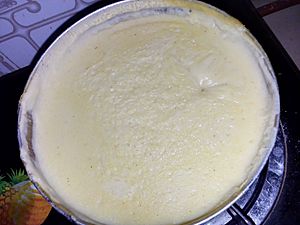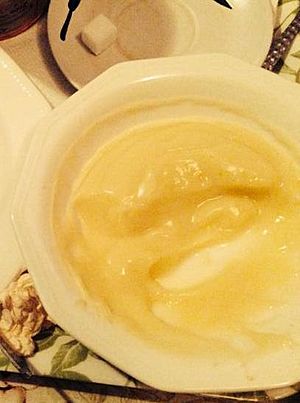Ogi (food) facts for kids
 |
|
| Alternative names | Akamu |
|---|---|
| Type | Pap or pudding |
| Place of origin | Nigeria, Kenya, Cameroon |
| Region or state | West Africa |
| Main ingredients | Maize, sorghum or millet |
| Ingredients generally used | sugar |
| Variations | Uji in Kenya |
Ogi (also called Akamu) is a popular food from Nigeria. It is a creamy pudding or thick porridge. People make it from grains like maize (corn), sorghum, or millet. Ogi is a "fermented" food. This means helpful tiny living things, like good bacteria, change the grains. This process gives Ogi its special sour taste. It also helps to preserve the food. Many people enjoy Ogi for breakfast or dinner.
How is Ogi Made?
Making Ogi is a traditional process. First, the grains are soaked in water. This can take up to three days. Soaking makes the grains softer.
Next, the softened grains are ground. This is called "wet-milling." After grinding, the mixture is sieved. Sieving removes the tough outer husks. What's left is a smooth, liquid cereal.
This liquid cereal is then left to ferment. Fermentation can take up to three days. During this time, the helpful bacteria work. They give Ogi its unique sour flavor. Once fermented, Ogi is ready to be cooked. It can be boiled into a thick porridge, also known as pap. It can also be cooked into a creamy pudding. This pudding is sometimes called Agidi or Eko.
Where is Ogi Eaten?
Ogi is a very popular food in Nigeria. People often eat it with other dishes. These include moin moin, akara, or bread. The choice depends on what a person likes best.
In Kenya, a similar porridge is known as uji. Uji is usually made with millet and sorghum. It is often served for breakfast and dinner. Kenyan uji often has a thinner, gravy-like texture.
The Science Behind Ogi
The fermentation of Ogi happens because of tiny living things. These are called lactic acid bacteria. Some common types include Lactobacillus species. There are also different types of yeasts involved. These include Saccharomyces and Candida species. These tiny helpers break down parts of the grains. This process creates the sour taste and thick texture of Ogi.
See also
 In Spanish: Ogi (alimento) para niños
In Spanish: Ogi (alimento) para niños


